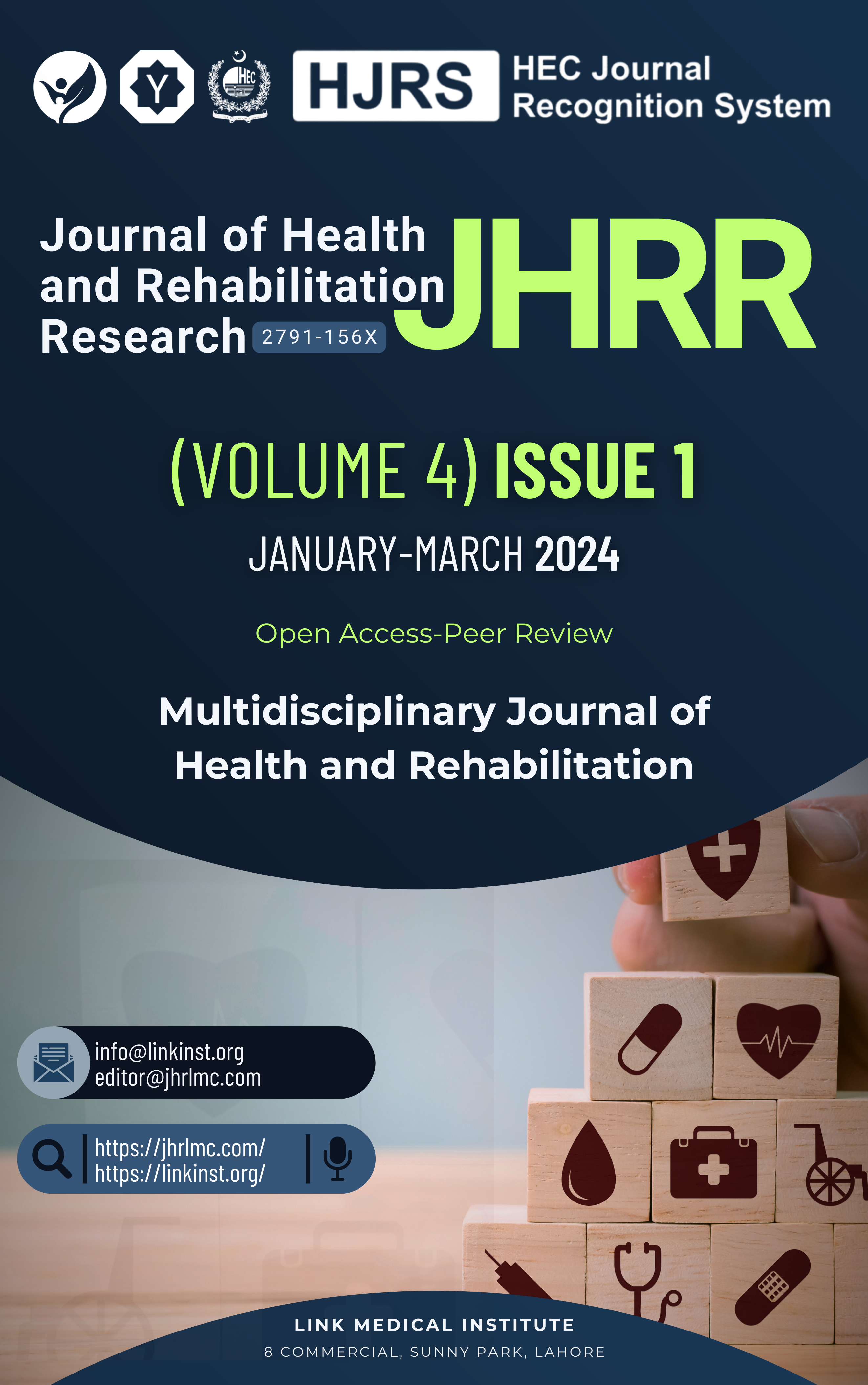Frequency of Perforated Appendix in Acute Appendicitis at BMC Hospital Quetta
DOI:
https://doi.org/10.61919/jhrr.v4i1.1764Keywords:
Perforated Appendicitis, Acute Abdomen, General Surgery, Surgical Complications, Peritonitis, Mortality, Morbidity.Abstract
Background: Perforated appendicitis remains a significant complication of acute appendicitis, contributing to increased morbidity and mortality, particularly in settings with delayed diagnosis. Despite advancements in surgical management, the incidence, risk factors, and outcomes of perforated appendicitis vary across populations, necessitating further investigation.
Objective: This study aimed to determine the frequency of perforated appendicitis among patients with acute appendicitis at BMC Hospital Quetta and evaluate the associated morbidity, mortality, and surgical outcomes.
Methods: This prospective observational study was conducted from October 19, 2023, to October 20, 2024, including 63 patients diagnosed intraoperatively with perforated appendicitis. Patients aged ≥12 years with confirmed perforation were included, while those with non-perforated appendicitis or appendicular mass were excluded. Data collection included clinical presentations, laboratory findings, intraoperative observations, and postoperative complications. Statistical analysis was performed using SPSS v27, with chi-square tests for categorical variables and logistic regression to assess risk factors. Ethical approval was obtained, and informed consent was secured.
Results: The perforation rate was 13.8%, with the highest prevalence in the 21–30-year age group (31.8%). The complication rate was 72.2%, and mortality was 4.8%, with severe peritoneal contamination (>150 ml) increasing mortality risk to 54.5%. Late presentation significantly correlated with adverse outcomes (p<0.05).
Conclusion: Delayed presentation and severe peritoneal contamination are key predictors of morbidity and mortality in perforated appendicitis. Early diagnosis and timely surgical intervention are essential to improving patient outcomes.
Downloads
References
Bhangu A, Søreide K, Di Saverio S, Assarsson JH, Drake FT. Acute Appendicitis: Modern Understanding of Pathogenesis, Diagnosis, and Management. Lancet. 2015;386(10000):1278-87. doi:10.1016/S0140-6736(15)00275-5.
Bickell NA, Aufses AH Jr, Rojas M, Bodian C. How Time Affects the Risk of Rupture in Appendicitis. J Am Coll Surg. 2006;202(3):401-6. doi:10.1016/j.jamcollsurg.2005.11.014.
Sartelli M, Baiocchi GL, Di Saverio S, Ferrara F, Labricciosa FM, Ansaloni L, et al. Prospective Observational Study on Acute Appendicitis Worldwide (POSAW). World J Emerg Surg. 2018;13:19. doi:10.1186/s13017-018-0179-0.
Di Saverio S, Podda M, De Simone B, Ceresoli M, Augustin G, Gori A, et al. Diagnosis and Treatment of Acute Appendicitis: 2020 Update of the WSES Jerusalem Guidelines. World J Emerg Surg. 2020;15(1):27. doi:10.1186/s13017-020-00306-3.
Earley AS, Pryor JP, Kim PK, Hedrick JH, Kurichi JE, Minogue AC, et al. An Acute Care Surgery Model Improves Outcomes in Patients with Appendicitis. Ann Surg. 2006;244(4):498-504. doi:10.1097/01.sla.0000237756.76716.f7.
Wray CJ, Kao LS, Millas SG, Tsao K, Ko TC. Acute Appendicitis: Controversies in Diagnosis and Management. Curr Probl Surg. 2013;50(2):54-86. doi:10.1067/j.cpsurg.2012.09.001.
Rentea RM, Peter SD, Snyder CL. Pediatric Appendicitis: State of the Art Review. Pediatr Surg Int. 2017;33(3):269-83. doi:10.1007/s00383-016-3990-2.
Cironi K, Albuck AL, McLafferty B, Mortemore AK, McCarthy C, Hussein M, et al. Risk Factors for Postoperative Infections Following Appendectomy of Complicated Appendicitis: A Meta-Analysis and Retrospective Single-Institutional Study. Surg Laparosc Endosc Percutan Tech. 2024;34(1):20-8. doi:10.1097/SLE.0000000000001103.
Viradia NK, Gaing B, Kang SK, Rosenkrantz AB. Acute Appendicitis: Use of Clinical and CT Findings for Modeling Hospital Resource Utilization. Am J Roentgenol. 2015;205(3):W275-82. doi:10.2214/AJR.14.13468.
El Zouki AN, Zahid M. Free Communications of the Third Qatar Internal Medicine Conference; 6-8 October 2016; Doha, Qatar. Ibnosina J Med Biomed Sci. 2016;8(5):219-58. doi:10.4103/1947-489X.193423.
Berger PB, Ryan TJ. Inferior Myocardial Infarction: High-Risk Subgroups. Circulation. 1990;81(2):401-11. doi:10.1161/01.CIR.81.2.401.
Mueller HS, Cohen L, Braunwald E, Forman S, Feit F, Ross A, et al. Predictors of Early Morbidity and Mortality After Thrombolytic Therapy of Acute Myocardial Infarction. Circulation. 1992;85(4):1254-64. doi:10.1161/01.CIR.85.4.1254.
Mamede RC, Mello Filho FV. Ingestion of Caustic Substances and Its Complications. Sao Paulo Med J. 2001;119(1):10-5. doi:10.1590/S1516-31802001000100003.
Jauregui LE, Babazadeh S, Seltzer E, Goldberg L, Krievins D, Frederick M, et al. Randomized, Double-Blind Comparison of Once-Weekly Dalbavancin Versus Twice-Daily Linezolid Therapy for the Treatment of Complicated Skin and Skin Structure Infections. Clin Infect Dis. 2005;41(10):1407-15. doi:10.1086/497143.
O'Guinn ML, Keane OA, Lee WG, Feliciano K, Spurrier R, Gayer CP. Clinical Characteristics of Avoidable Patient Transfers for Suspected Pediatric Appendicitis. J Surg Res. 2024;300:54-62. doi:10.1016/j.jss.2023.10.010.
Metal Landscape. J Health Rehabil Res. 2023;3(2):351-6.
Downloads
Published
How to Cite
Issue
Section
License
Copyright (c) 2024 Muhammad Riaz, Ahmad Shah, Zahid Saeed, Nazeer Ahmed Sasoli, Ghulam Mustafa, Bilal Masood, Meharullah Kasi

This work is licensed under a Creative Commons Attribution 4.0 International License.
Public Licensing Terms
This work is licensed under the Creative Commons Attribution 4.0 International License (CC BY 4.0). Under this license:
- You are free to share (copy and redistribute the material in any medium or format) and adapt (remix, transform, and build upon the material) for any purpose, including commercial use.
- Attribution must be given to the original author(s) and source in a manner that is reasonable and does not imply endorsement.
- No additional restrictions may be applied that conflict with the terms of this license.
For more details, visit: https://creativecommons.org/licenses/by/4.0/.






